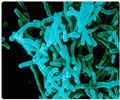Currently, production of polio vaccine requires the growth of enormous quantities of live virus, which is then chemically killed.

‘New ways to provide vaccines against polio, which do not require the growth of live virus for their manufacture, have been identified.’





Despite the success of vaccines produced from 'virus-like particles'
(VLPs) for hepatitis B and human papilloma viruses, poliovirus VLPs
have proved to be too unstable to make practical vaccines.Now, a research team at the University of Leeds has found a new way to modify these VLPs, also known as 'empty capsids' by identifying mutations which make their structures sufficiently stable to act as vaccines.
The empty capsids change shape when warmed and become unusable as vaccines, but the mutations identified in this research prevent these damaging changes.
The new stabilized VLPs are suitable as replacements for the current killed poliovirus vaccines and can be produced in ways that do not require the growth of live virus.
The Leeds team and collaborators say this form of vaccine, using the newly developed stabilized VLPs, would be best used after the virus has been eradicated.
Advertisement
This study was a lab experiment, which shows stabilized VLPs to be effective in a controlled environment. Further research using animals (rats and mice) is planned, as part of the essential process of making sure the new VLPs are safe and effective for use in humans.
Advertisement
"Further research is needed to refine them more but we are confident they will work for all three forms of polio. After that we need to find a way to manufacture them cost effectively on a large scale."
Source-Eurekalert













